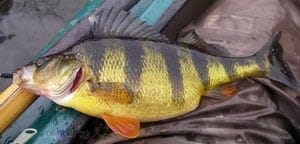Submitted By:
Wade Bourne, Vicious Pro Staff
Crappie, bluegill, perch and other panfish are popular targets for anglers, and jigs are among the best lures to catch these fish. However, many fishermen could improve their success by going smaller and lighter in terms of the tackle and jig sizes they use. Smaller panfish have an affinity for “little bites.”

This means casting a 1/16 or 1/32 oz. leadhead jig, sometimes tipped with a small minnow or a wax worm, depending on the species you’re after. For crappie, perch, walleye or bass, use a minnow. For bluegill, tip with a wax worm.
The best rig for casting such a small bait is a 7-foot light action spinning rod/reel spooled with 4 or even 2 lb. test line. With such a rod/line combination, anglers can cast small jigs easily and work them back with the sensitivity needed to detect subtle bites.
In the spring, cast these little jigs around steep-sloping rocky banks, brushpiles, dock or bridge pilings, gravel bars or other structure where panfish will stage and feed before spawning. If the spawn is on, seek out and work areas where your target species should be clustered to lay their eggs.
Tiny jigs may be fished without a float with a slow lift-and-fall retrieve. When you feel a “tick,” reel up slack and lift with your rod tip. Or they may be suspended under a float and reeled in slowly and steadily. If you have a depthfinder, fix the float so the bait hangs at the depth where you see the most fish returns. If you don’t have a depthfinder, try to guess the depth of the water and suspend your jig a few inches above bottom.
So again, small jigs and light tackle are a recipe for a lot of action with panfish. With light tackle you have to learn to play the fish instead of “horse them in,” but this adds to the excitement – and the success – of your fishing experience.



